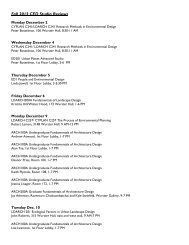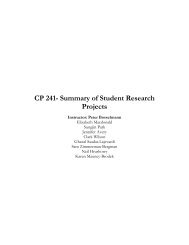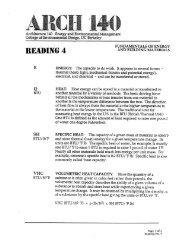Project 2 The Artifact.pdf - College of Environmental Design
Project 2 The Artifact.pdf - College of Environmental Design
Project 2 The Artifact.pdf - College of Environmental Design
You also want an ePaper? Increase the reach of your titles
YUMPU automatically turns print PDFs into web optimized ePapers that Google loves.
Q<br />
R<br />
<strong>Project</strong> 2: <strong>The</strong> <strong>Artifact</strong><br />
ENVIRONMENTAL DESIGN 4 Spring 04<br />
Pr<strong>of</strong>essor: W. Mike Martin<br />
GSI: Tadd Andersen, Howard Blecher, Laura Boutelle, Karen Mauney-Brodek<br />
Collage:<br />
1. A technique <strong>of</strong> composing a work <strong>of</strong> art by pasting on a single surface various materials not normally associated<br />
with one another, such as newspaper clippings, theater tickets, fragments <strong>of</strong> an envelope, etc.<br />
2. A work <strong>of</strong> art produced by this technique.<br />
Assemblage:<br />
Fine arts: a sculptural technique <strong>of</strong> organizing or composing into a unified whole a group <strong>of</strong> unrelated and <strong>of</strong>ten<br />
fragmentary or discarded objects.<br />
Ben Nicholson from <strong>The</strong> Appliance House<br />
“A trained collagist requires the act <strong>of</strong> collage making to be contemplative, they know that there is something within<br />
the soul that longs to come forward, so they engage in collage making to advance it. To express this longing all<br />
the printed ephemera, forming the mirror world <strong>of</strong> modern existence, is mustered for use. Thousands <strong>of</strong> pictures <strong>of</strong><br />
things varying in scale and perspective are conscripted to trigger trains <strong>of</strong> thoughts, comprehensible or not.<br />
Bibliomaniac safaris, considered <strong>of</strong>f limits in respectable scholarship, are taken through trashy magazines, highbrow<br />
periodicals or well-loved books. Pictures are snipped without care for their actual context, and splicing<br />
together <strong>of</strong> this unique selection <strong>of</strong> things can begin.<br />
Acts are turned against pictorial depictions, recognizable or not. Things are done to pictures that have always<br />
wanted to be done but, because <strong>of</strong> circumstances, they never took place. Fifteen handles can be attached to a<br />
frying pan with a few deft strokes <strong>of</strong> a knife. Fingers can be repositioned so that they grow out <strong>of</strong> ears. <strong>The</strong>n<br />
depending on the interest, skill, and dexterity, thoughts can be articulated. When the work is complete, a map <strong>of</strong><br />
hunches exists and, due entirely to the act <strong>of</strong> making, the soul temporarily exorcised <strong>of</strong> what appeared to be<br />
coagulating within. Like all maps, collage can exist as a guide to what exists on the ground or it can prompt a new<br />
set <strong>of</strong> thoughts suggested by interconnections <strong>of</strong> terrain and cities. <strong>The</strong> activity <strong>of</strong> collage, like every visual activity,<br />
can pr<strong>of</strong>oundly alter the way things, places, and ideas are viewed.”<br />
In this project you are asked to work within a spirit <strong>of</strong> collage or assemblage to produce an artifact that<br />
communicates an understanding <strong>of</strong> a site (chosen from the selection <strong>of</strong> sites on the accompanying map.) This<br />
analysis <strong>of</strong> a site should be engaged through the production <strong>of</strong> an artifact in multiple modes.<br />
1. A critical analysis <strong>of</strong> observed relationships, circumstances or issues regarding the site.<br />
2. An interpretation or your experiences, impressions and ideas regarding the site.<br />
Requirements:<br />
1. Documentation <strong>of</strong> four aspects <strong>of</strong> a site through sketches, diagrams, materials, etc. Material should be<br />
presented on 8.5” x 8.5” sheets <strong>of</strong> paper.<br />
2. Produce two translations based on requirement 1 on 8.5” x 8.5” sheets <strong>of</strong> paper. You may want to explore your<br />
aspects individually, or in combination/juxtaposition to reveal relationships within your site.<br />
3. <strong>The</strong> <strong>Artifact</strong>: should be <strong>of</strong> a base dimension 11” wide x 11” long x a dimension thick enough to support your<br />
collage. <strong>The</strong> final artifact must be three dimensional and have a minimum height <strong>of</strong> 1” from the base.<br />
4. For Final review: Assemble requirement 1 and 2 on a presentation board, you may want to put additional text,<br />
captions or other material gathered to explain your artifact.<br />
Deadlines:<br />
February 17/19 Be ready to discuss Requirement 1 in section<br />
February 24/26 Requirement 2 and a sketch <strong>of</strong> Requirement 3 due in section<br />
March 2 <strong>Project</strong> 2 due in Wurster Lobby!
?<br />
i<br />
ENVIRONMENTAL DESIGN 4 Spring 04<br />
Pr<strong>of</strong>essor: W. Mike Martin<br />
GSI: Tadd Andersen, Howard Blecher, Laura Boutelle, Karen Mauney-Brodek<br />
You may think <strong>of</strong> an <strong>Artifact</strong> as something based on what is uncovered or revealed at the site. It is not an invention or a<br />
designed object necessarily. <strong>The</strong> artifact is shaped by the site and those that inhabit it. For example, consider a line <strong>of</strong><br />
movement which potentially reflects directionality, speed, density or accessibility <strong>of</strong> a site. How can this non-physical<br />
phenomenon be realized in a physical form? How can a material and its properties (through its thickness, grain,<br />
reflectivity, transparency, etc.) be used to represent these lines <strong>of</strong> movement? How can you represent the physical<br />
aspects <strong>of</strong> a site through a different material? How does your artifact enable new understanding <strong>of</strong> your site?<br />
Sites:<br />
1. North Gate<br />
2. Free Speech Movement Café in M<strong>of</strong>fitt Library<br />
3. Strawberry Creek (section near Stephens and Moses)<br />
4. Café Milano (2552 Bancr<strong>of</strong>t Way, Berkeley)<br />
5. Berkeley Art Museum Garden<br />
6. Telegraph Avenue between Dwight and Haste




![Part 2 [PDF] - College of Environmental Design](https://img.yumpu.com/6874370/1/190x146/part-2-pdf-college-of-environmental-design.jpg?quality=85)

